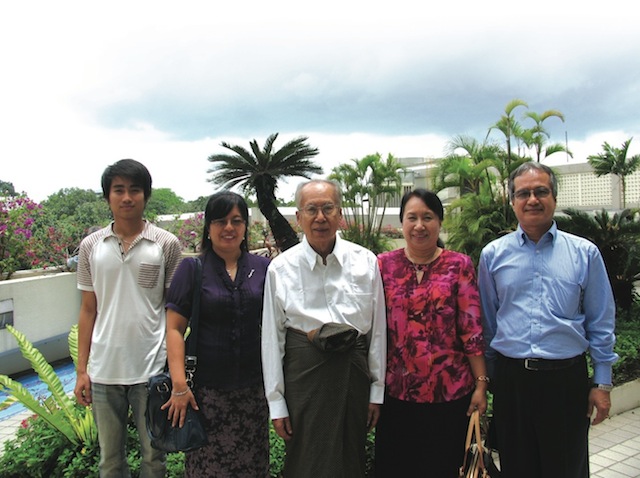Conquering cancer at 84
A wonderful testimony for elderly cancer patients, U Gyan fought – and won – his battle with rectum cancer.

U Gyan with his family.
Eighty-four-year-old U Gyan from Myanmar was first diagnosed with cancer of the rectum several years ago and had surgery in a hospital in Singapore to remove the tumour. He was then recommended to have chemotherapy. However, due to side effects such as nausea, tiredness and diarrhoea, he stopped treatment after just two cycles.
He was well until late 2009 when his cancer recurred in the rectum, giving rise to discomfort and change in bowel habits. The tumour was rather extensive and his doctor in Myanmar assessed that they had to sacrifice his anus in order to remove the tumour completely. He would then have to live with a colostomy. They also felt that surgery to remove the tumour would be risky because of his age.
Another opinion
It was then that Dr Khoo Kei Siong, deputy medical director and senior consultant, Medical Oncology, at Parkway Cancer Centre (PCC), paid a visit to U Gyan in Mandalay, Myanmar, for a diagnosis. “I first saw him in Mandalay during one of my visits there,” said Dr Khoo. “We chatted through an interpreter. He spoke little, but I was struck by his calmness and quiet confidence. He was quite clear that living with a permanent colostomy was an option that he did not want.”
He added: “He looked his age, but was physically fit and mentally sharp. I felt he stood a chance of a cure, while getting away with a permanent colostomy. It would not be easy because he would need radiation therapy and chemotherapy. Given his age and this being his second surgery to the pelvis, the risk and degree of difficulty would also higher.”
Further evaluation in Singapore revealed that U Gyan indeed had a locally invasive tumour in the rectum, but it showed that did not spread to other parts of the body. In order to give him the best chance of preserving the anus, he was treated with radiotherapy, together with chemotherapy first, to achieve maximum reduction in size and extent of the tumour before the surgery was attempted.
As Mandalay does not have a direct flight to Singapore, U Gyan had to make his trips to Singapore via Yangon. Despite that, he came regularly to Singapore for follow-ups and treatments.
Good news
Dr Khoo said, “Overall, U Gyan took to the chemotherapy and radiotherapy reasonably well. His kidney function declined somewhat during the treatment and his appetite suffered. We had to monitor him closely and make adjustments to the treatment programme in order to keep the toxicity low without compromising its efficacy.
“Fortunately, there was no major side effects and he completed the treatment as planned. Further evaluation showed a very good response of the tumour to radiotherapy and chemotherapy, with significant reduction in tumour activity and size.”
U Gyan eventually went for surgery, which was very difficult because the tumour was stuck to the surrounding tissue as a result of local invasion (this means the tumour has invaded into the surrounding tissue and different from metastasis, which is the spread of the cancer to an organ away from the primary tumour, such as the rectum in this patient) and the previous surgery. PCC’s colorectal and general surgeon spent nearly five hours painstakingly dissecting and removing the tumour completely.
U Gyan had a temporary colostomy to allow the anastomosis (a surgical connection between two structures) at the rectum to heal. This was closed after three months and he now passes motion normally. Following which, he underwent chemotherapy for a month.
Dr Khoo shared, “It is always a challenge to manage elderly cancer patients. On one hand, we would like to offer the treatment that offers the best outcome, be it complete removal of cancer or longer survival. On the other hand, we need to be careful not to cause severe or life-threatening side effects. A balanced approach and good judgment is necessary to select the most suitable patients for potentially life-saving treatment. U Gyan is one such example.”
** This story first appeared on the website of Parkway Cancer Centre. It has been reprinted with permission.

0 Comments